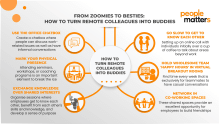Have a plan in place if your star performer quits

Organisations identify people based on performance and potential. But don't have a strong enough ecosystem to create potential
Attrition is not a new concept, nor is it new that our best employees will ALWAYS have options outside, and will be pursued by our competitors
That is the Beatles classic with a slight twist. To me, it has become a frantic alarm from professional friends and colleagues in the last few weeks. I was so amazed by the frequency of the requests that I changed my ring tone to this song. So there! The phone goes off a little embarrassingly in the middle of a meeting, belting out ‘Help’ in its loud, polyphonic rendition of the Beatles.
Why this ring tone? Well, these days so many people are either catching me on Facebook or LinkedIn or at a conference, and they all have the same thing to say: “My best team member is about to quit! What do I do?” or “I know this leader is going to leave and I have no back-up!” or “I have a really great manager who is holding me to ransom if I don’t do certain things and I have no alternatives to replace him. Help! Please get me anybody, I can’t have that critical position vacant.”
I am surprised that after over hundred years of experience, we have still not been able to understand the age-old saying, “Hope for the best, but plan for the worst.” People have not started leaving jobs suddenly. They have been doing this for some time, and in recent times, a lot more frequently. Yet it seems, from these conversations, that for most folks, ‘Plan B’ is destiny.
Attrition is not a new concept, nor is it new that our best employees will ALWAYS have options outside, and will be pursued by our competitors. It is also true that even the most loyal, well paid, and happy team members will sometimes want a change of scene and take another job.
Yet nine times out of ten, I see that people are caught by surprise. A key leader quits, and there is a mad scramble, followed by a painful realisation that we have nobody who can step into her shoes. Leaving us with no option but to beg, plead, double the salary, and sell the family silver to retain them or still lose them.
Of course, cloning is an option….well, while they may have cloned sheep, but we are a far cry from building intellectual armies (conspiracy theorists, feel free to comment!). But that is not what I mean. What I am trying to say is that we always try and troubleshoot after the trouble has happened. We plan and strategise as a reaction, when we know someone wants to move out. Why not build that intellectual army by strengthening our learning agility?
It is not like we have not tried. I am sure every CHRO worth his fancy leather chair lords over a talent management programme where you identify high potentials, put in succession plans, etc.
And yet we find ourselves in this bind rather frequently.
Here is my diagnosis and some suggestions:
For years, our talent management programmes have identified people based on performance and potential. It’s a good practice. The gap, we discovered, was that we didn’t have a strong enough ecosystem to create potential. We drove the car with our eyes closed, and hoped that it would lead us in the right direction.
Instead, what if we institute a strong learning wrapper around the organisation that leverages our learning function? Rather than focus on identifying people, why not shift gears to training and creating learning environments so that employees have the support they need to not only reach, but also succeed at the next level? And I am not just talking about webinars and classrooms. We have created a framework that will guide employees to learning programmes that are tailored to their style -- whether it is in a classroom, on the job, or through CSR activities.
However, the key elements are: self-selection, credits, and role-modeling. Let me explain.
Self-Selection
Managers will nominate no more. Performance will be the driver for the selection for prized assignments and learning opportunities. Put up all assignments on a portal and let leaders raise their hands and pick it up. Likewise, managers should not enforce stretch assignments but open them up for leaders to pick them up themselves. Create what I call the culture of moonlighting, where leaders continue to do their jobs and pick up assignments over and above.
Credits
Leaders create credentials based on the assignments they do. They then use these credentials to bid for training programs. By this measure, a leader can bid for an Advanced Management Programme in a global programme.
Role-modeling
We continue to showcase the leaders who exhibit learning agility and willingness to adapt. The entire reward and recognition ecosystem has to change.
And, the link to it all…if someone wants to aspire higher, they can drive their own learning and nominate themselves for high potential programmes - no judgment, no biased views of a leader, no guesstimate of readiness, only an employee who has taken the time to learn, prepare, and adapt to what is required, and is now stepping up to the next level.
So, in conclusion, the message I hope that you will walk away with is:
The problem is not new, nor is the solution complex.
Don’t wait for the rain to fall to buy an umbrella.
Learn, adapt and achieve.
The market has changed; the question is, has the preparedness of our leaders and the expectation from leaders changed? As of now, the answer is no. But we in HR can make it a ‘Yes’, and we don’t have to vent our frustration through fancy ringtones!
As always, would love to hear your feedback.
Elango R is the Chief Human Resources Officer at MphasiS and author of the book You Don’t Need a Godfather. You can read his blog on www.ElangoR.com and follow him on Twitter @agastyasays











